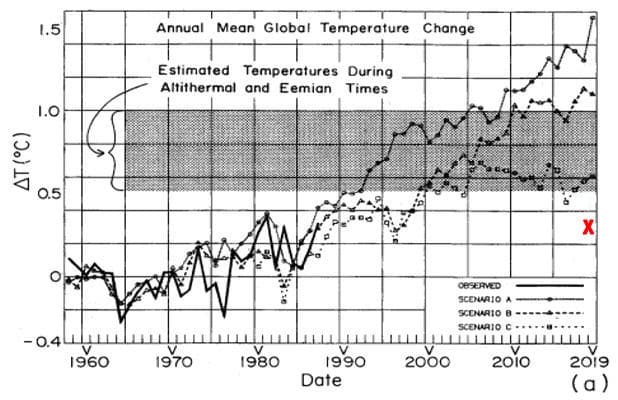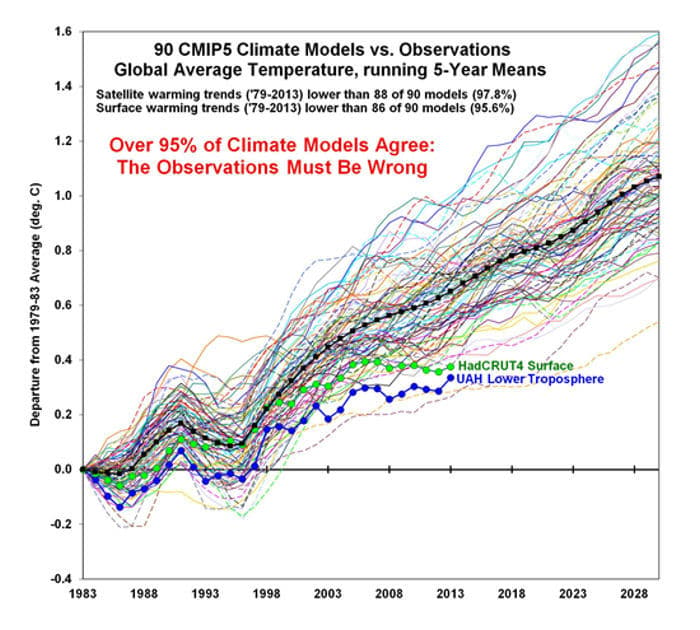The concern regarding potential catastrophic anthropogenic climate change is based upon projected future conditions produced by unverified climate models driven by uncertain climate sensitivity, feedbacks and forcings. Therefore, it is interesting and instructive to periodically assess the accuracy of the climate model projections relative to the observations of global temperature. In this context, it is important to remember that the observations of near-surface temperature are routinely “adjusted” and thus are no longer the actual observations originally recorded. It is also important to remember that the models have been “hindcast” over a prior period, compared to the observations over that prior period and then “tweaked” to minimize the differences between the model output and the observations.
The most famous of the climate models and the model with the longest projection period after “tweaking” is the climate model used by Dr. James Hansen of NASA GISS as the basis for his 1988 presentation to Congress. Hansen modeled three CO2 emissions scenarios:
Scenario A: Continued annual emissions growth of ~1.5% per year
Scenario B: Continued emissions at current (mid-1980s) rates
Scenario C: Drastically reduced emissions rates from 1990 – 2000
Scenario A, which projects the greatest warming based on continued “business as usual” emissions growth, projected a 2018 temperature anomaly of approximately 1.3°C.
Scenario B, which projects more moderate warming based on relative emissions stability in the future, projected a 2018 temperature anomaly of approximately 1.15°C.
Scenario C, which projects the least warming based on drastically reduced emissions in the future, projected a 2018 temperature anomaly of approximately 0.6°C
Emissions since Hansen’s presentation have approximated the emissions path in Scenario A. The observed HadCRUT near-surface temperature anomaly in 2018 was approximately 0.32°C (X in graph), or approximately half of Hansen’s Scenario C projection and approximately one quarter of Hansen’s Scenario A projection. Clearly, Hansen’s model has been falsified.
“It doesn't matter how beautiful your theory is, it doesn't matter how smart you are. If it doesn't agree with experiment, it's wrong.” Richard P. Feynman

There are numerous climate models other than the Hansen model, most of which are included in the Coupled Model Intercomparison Project (CMIP5). The projections of 90 of these models are compared with each other and with the observations of both the HadCRUT4 near-surface temperature anomaly observations and the UAH lower tropospheric temperature observations through 2013 in the graph below prepared by Dr. Roy Spencer of UAH. As noted above, the HadCRUT near-surface temperature anomaly in 2018 was approximately 0.32°C. The UAH lower tropospheric temperature anomaly in 2018 was approximately 0.23°C. Both of these observed anomalies remain below all but 1 or 2 of the 90 models.

The black line plotted through the outputs of the 90 models is typically referred to as the model mean, or the mid-point of the model outputs in each year. The HadCRUT4 anomaly in 2018 is approximately 40% of the model mean, while the UAH 2018 anomaly is approximately 29% of the model mean. This suggests that the model mean is essentially meaningless, since it is the mean of the outputs of 90 models, 88 of which are already demonstrably inaccurate. Note that these models appear to have been “tweaked” approximately 20 years ago, so that the period of projection is only 20 years, compared to the 30-year period assumed to represent climate.
Clearly these models are being progressively falsified by ongoing observations. Equally clearly, these models are not a solid basis upon which to develop public policies regarding climate change.


